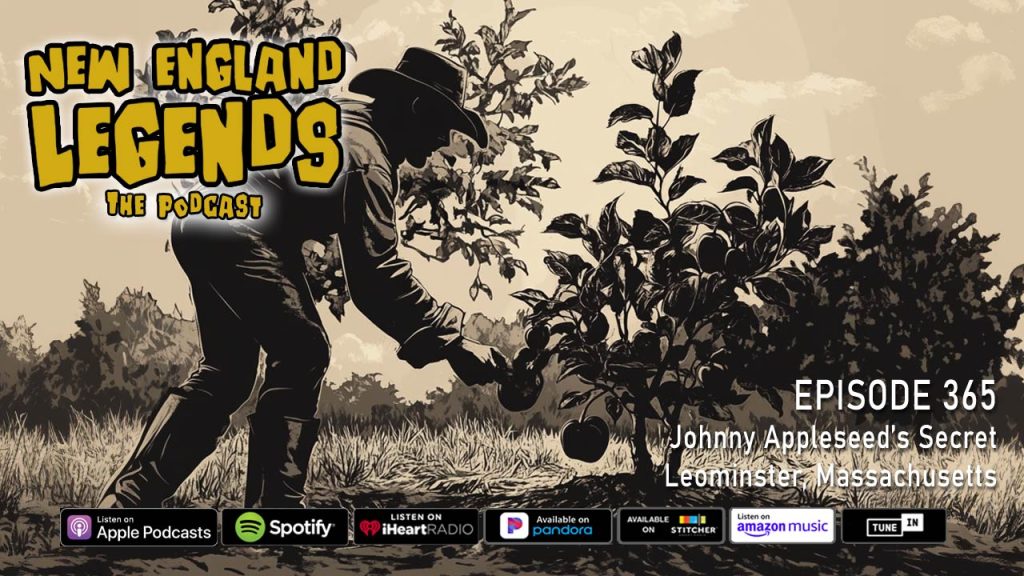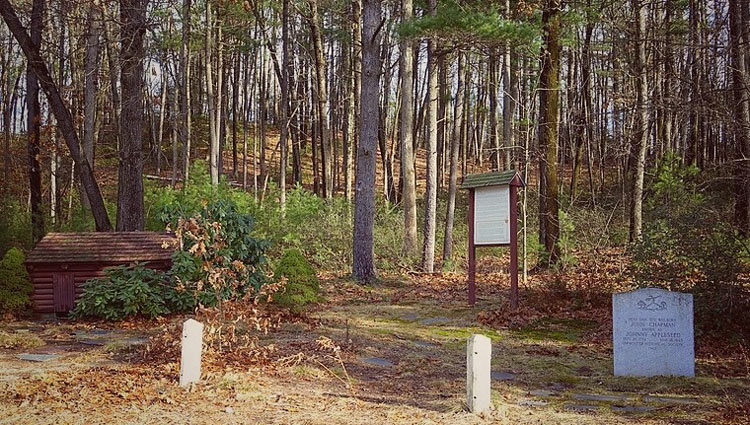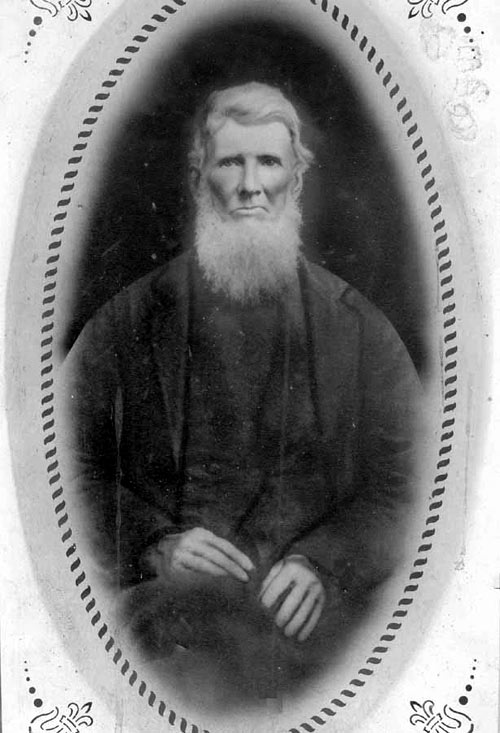
In Episode 365 Jeff Belanger and Ray Auger explore Leominster, Massachusetts, to search for the birthplace of John Chapman, an eccentric orchardist who became better known as Johnny Appleseed. But there’s a Johnny Appleseed secret that all the children’s book left out… Happy Johnny Appleseed Day (September 26th)!
BECOME A LEGENDARY PATRON:
https://www.patreon.com/NewEnglandLegends
CREDITS:
Produced and hosted by: Jeff Belanger and Ray Auger
Edited by: Ray Auger
Theme Music by: John Judd
SUBSCRIBE TO THE PODCAST FOR FREE:
Apple Podcasts/iTunes | Spotify | Pandora | Amazon Podcasts | TuneIn | iHeartRadio
JOIN OUR SUPER-SECRET:
New England Legends Facebook Group


EPISODE TRANSCRIPT:
*A note on the text: Please forgive punctuation, spelling, and grammar mistakes. Like us, the transcripts ain’t perfect.
[CRUNCH INTO APPLE]
[OUTDOOR SOUNDS]
RAY: It wouldn’t be Autumn in New England without apples picked right off the tree!
JEFF: So true, Ray. I look forward to this time of year for so many reasons. It means Halloween is coming, the air turns crisp, pumpkin flavored everything if you’re into that. And yeah, the apples this time of year are truly a religious experience. Got a favorite?
RAY: I love Macintosh apples. How about you?
JEFF: I love honey crisps. And Jona Golds. Tart, sweet. So good.
RAY: There are tons of orchards all over New England. What brings us to this one in Leominster, Massachusetts?
JEFF: Ray, we’ve come to Leominster to witness the birth of a legendary person named John Chapman. A person who has become synonymous with Autumn and our favorite seasonal fruit. People think they know all about him, but I assure you there’s a twist. Though he was born John Chapman, the world knew him better as Johnny Appleseed.
[INTRO]
JEFF: I’m Jeff Belanger and welcome to Episode 365 of the New England Legends podcast.
RAY: And I’m Ray Auger. Thanks for joining us on our mission to chronicle every legend in New England one story at a time. And thank you to everyone who joined me and Jeff for our New England Legends LIVE show this past Saturday. We had such a blast with you all sharing music and stories.
JEFF: We did! I know this week’s story came up at the show, but we also have received multiple emails asking when we’re going to do it. So here we are. Most of our story leads come from you, so please contact us anytime through our Web site.
RAY: We’ll go searching for John Chapman right after this word from our sponsor.
SPONSOR
RAY: Everyone knows about Johnny Appleseed, don’t they?
JEFF: Yeah, I think we all read books about him in elementary school. I like that he got famous for his kindness, being an eccentric, and caring deeply about the environment and people.
RAY: We all know he planted apple trees all over the place.
JEFF: He did. That’s true, but there’s a part of his story the Disney movies and children’s books always leave out. But not us.
[APPLE CRUNCH]
JEFF: Okay, so that Macintosh apple you’re eating.
RAY: Yeah?
JEFF: There’s seeds inside of it.
RAY: Obviously.
JEFF: If you plant those seeds and water the seedlings into a tree, that tree might one day bear fruit.
RAY: Yes, that’s how this all works. Are you going to tell me about the birds and bees too?
JEFF: Ha! No. But did you know the fruit from the tree grown by your apple seeds may not be Macintosh apples at all.
RAY: Really?
JEFF: They might be some kind of sweet apple, but they will most likely be a crab apple.
RAY: I had no idea.
JEFF: The way we get the various varieties of apples, is by grafting them. If you have a tree that produces an apple you like, you would cut a branch from that tree, cut a notch into another apple tree, and then let them fuse together. Now you’ll get that variety of apple.
RAY: This sounds like genetically modified food!
JEFF: It is! And we’ve been doing it for centuries. Every apple you’ve ever eaten is genetically modified. Anyway, we don’t want to get too far off course here.
RAY: Right. We’re talking about Johnny Appleseed.
JEFF: It’s only fitting we should start at the beginning. Let’s hop in the car.
[DOORS CLOSE / CAR STARTS / DRIVES OFF]
RAY: Okay, we’re driving down Mechanic Street in Leominster, and just passed under Interstate 190.
JEFF: We’ll be making a left just ahead.
RAY: Where? I’m not…. Oh. Never mind. I guess it’s obvious, huh?
JEFF: That it is.
[BLINKAH]
RAY: We’re making a left onto Johnny Appleseed Lane.
JEFF: And our destination will be coming up on the left. (PAUSE) There it is by those stone pillars.
RAY: I see it.
[CAR STOPS / WE GET OUT]
RAY: There are some stone pillars next to the road. There’s a tombstone-looking marker that reads: Near this site was born John Chapman, known as Johnny Appleseed. September 6, 1774 to March 18, 1845. Leominster Historical Society 1963.
JEFF: So near here was where Johnny Appleseed was born.
RAY: And there’s a miniature log cabin over there. It’s maybe waist-high. And another historic marker behind it.
JEFF: So young John Chapman was born here just before the American Revolution.
RAY: Here’s a little more background. John was the second child of Nathaniel and Elizabeth Chapman. Young John was only two years old when his mother died during childbirth for the couple’s second son. The infant died just a few days after his mother.
JEFF: John’s father was a minuteman, and with a Revolution brewing, he knew his young children would need someone to care for them. Captain Nathaniel Chapman traveled to the Springfield Arsenal and left his son and daughter in the care of his wife’s family. In July of 1780, Captain Chapman married 18-year-old Lucy Cooley of Longmeadow, Massachusetts. That couple would go on to have ten children together. At some point, John came out to Longmeadow to join his father and half-siblings.
RAY: When John was in his late teens, he persuaded his 11-year-old half brother Nathaniel to go west with him. The two brothers lived like nomads hopping from place to place until the two parted ways.
JEFF: John Chapman’s history gets a little vague, but sometime in the 1790s he finds himself in Pennsylvania learning the apple orchard business. He’d gather seeds from cider mills, and continued his nomadic ways with a twist. We’ll pick it up from the year 1801.
[TRANSITION]
[SPRING BIRDS]
RAY: It’s Spring of 1801 and we’re walking through the open fields of Ohio Territory. This is still mostly untamed land, but settlers are changing that. Up ahead, we see the man we’re looking for.
JEFF: Yeah, that’s him! He’s not very tall, is he?
RAY: No. He’s a skinny, short guy.
JEFF: He’s not wearing shoes. His clothes look pretty ratty, and he’s got a metal cooking pot on his head for a hat with long dark hair sticking out under it. He’s got a beard that’s not very long, but still unkempt. He’s carrying a bag with him, but it’s not very large.
RAY: This guy travels light.
JEFF: He does. He’s deeply religious, he’s a vegetarian, and believes every creature on earth is sacred. He views himself as a missionary as much as an apple guy. It looks like he’s setting up a little camp for the night.
[CAMP FIRE]
JEFF: He’s using the pot from his head to heat up his dinner over the fire.
RAY: There’s something about this guy. There’s endless energy coming off of him. His eyes seem to sparkle whether he’s looking at the fire or just walking along.
JEFF: There IS something about him. I can see it.
RAY: Huh… something has startled him. He just jumped up and is covering the fire with his cooking pot to extinguish it.
JEFF: Some mosquitoes got too close to the fire and were burning up. He said he’d rather be cold than harm a living thing. And that’s the kind of guy he is.
[ROOSTER CROWS]
RAY: Chapman gets an early start to his day.
[WALKING]
JEFF: Pretty soon, Chapman finds a piece of land that would be perfect for an orchard. He finds the landowner and soon works out a deal where Chapman will plant the apple trees and get them growing, he’ll fence in the area so animals don’t come and eat the leaves off the trees, and then the landowner can tend to the trees selling the apples, and selling the more mature trees as well.
RAY: It’s a deal Chapman repeats over and over again. Sometimes, Chapman uses his profits to purchase acres of land to start the orchard, and then reaps all of the rewards himself.
(PAUSE)
JEFF: Time passes. Years go buy, and Chapman now owns hundreds of acres of land across three different states.
RAY: So he’s not really poor?
JEFF: Not at all. He dresses like a pauper, but by most standards, he’s rich!
RAY: Even in the winter, Chapman walks barefoot. Nothing seems to slow this guy down.
JEFF: Not only is he enterprising, he’s devout in his faith. He never misses an opportunity to teach others—especially children—about his faith and church. This guy is authentic in everything he does. He talks the talk, and he walks the walk.
RAY: His reputation is spreading as fast as his orchards. Pretty soon, people start calling him Johnny Appleseed. The name suits Johnny, too. Orchards and his faith are his life.
JEFF: His generosity and random acts of kindness follow him everywhere he goes. Johnny had heard a local farmer intended to put down his injured horse. Johnny bought the horse, purchased some acres of land nearby where the horse could recuperate, and once the horse was healed, Johnny gave the animal to a farmer in need on the promise the farmer would treat the horse kindly.
RAY: The man is a living saint. He has no wife or children. He tells people if he doesn’t find his soulmate on earth he’s sure he’ll find her in heaven.
JEFF: As years turn to decades, Johnny Appleseed becomes the person behind dozens of orchards from New York through Pennsylvania, Ohio, and down to Indiana. And if you figure the seeds and trees from those orchards went on to start other orchards, it’s almost uncountable how many apples have grown from the hands of Johnny Appleseed—a guy who got his start in Leominster, Massachusetts. And that brings us back to today.
[TRANSITION]
RAY: If I’m remembering the children’s books I read about Johnny Appleseed as a kid, I was under the impressions he scattered seeds all over and the trees just grew.
JEFF: Yeah, that’s not quite right. He planted orchards and died a wealthy man in Fort Wayne, Indiana, in 1845. And here’s the twist I was telling you about earlier.
RAY: Right. That.
JEFF: Remember when I told you if you plant a seed from your Macintosh apple you likely won’t get sweet apples from that tree?
RAY: Yeah.
JEFF: It was true back then too. BUT… do you know what you can do with a bunch of non-sweet apples?
RAY: What?
JEFF: You can turn them into juice, let them ferment, and then you’ve got…
RAY: Alcohol!
JEFF: That’s right! Hard cider. All of those Johnny Appleseed trees got a lot of people pretty drunk. Before the early 1900s, apples were mainly used to make alcoholic cider. Only after the 1900s did orchardists get serious about grafting sweet-tasting apples that we’ve come to love today.
RAY: So not only was Johnny Appleseed spreading kindness and good cheer, he was getting people loaded. I respect that.
[OUTTRO]
JEFF: I’ll drink to that. And that brings us to After the Legend where we take a deeper look at this week’s story.
RAY: After the Legend is brought to you by our patreon patrons! Our patrons keep this train running. And we’d love to have you join us there. Our patrons get early ad-free access to new episodes, they get access to our entire archive of shows, they get discounts on tickets and merch, plus bonus episodes and content that no one else gets to hear. All for just $3 bucks per month. It’s only a little, but it helps us a lot. Head to patreon.com/newenglandlegends to sign up.
To see some pictures of Johnny Appleseed’s birth monument and other images related to him, click on the link in our episode description, or go to our Web site and click on episode 365.
Please hit the subscribe button wherever you get your podcasts. And tell a friend or two about our show. That’s how we grow. And the more people in our community, the more story leads that come in. Please also join us in our New England Legends Facebook group, and download our free New England Legends app in your app store so you can check these places out for yourself.
We’d like to thank our sponsors, thank you to our patreon patrons, and our theme music is by John Judd.
Until next time remember… the bizarre is closer than you think.
